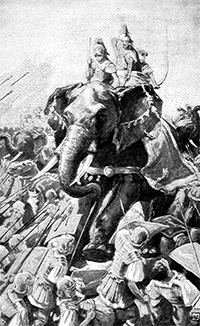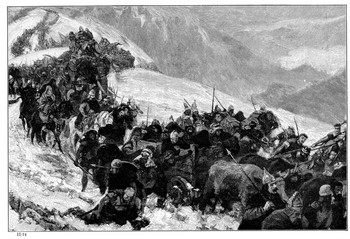The Roman Republic
Part 3: Wars and More Wars 
When the Roman Republic began, Tarquin the Proud, the last king of Rome, was still alive. He spent the next 13 years trying to regain his throne, raising armed forces here and there. After losing yet again, at the Battle of Lake Regillus in 496 B.C., he fled to Cumae, where he died the following year. Rome fought that battle against the Latins, who had allied themselves with Tarquin the Proud. Further Roman struggles against the Latins came at Mount Algidus in 458 B.C. and Corbio in 446 B.C. By this time, Rome was in control of much of its surroundings. In the early 4th Century B.C., Gallic tribes invaded two Etruscan towns not far from Rome. The Romans sent troops to fight against the Gauls. The resulting Battle of Allia River, fought beginning about 390 B.C. and lasting a few years, resulted in a Roman defeat and, further, the sack of Rome itself, as the victorious Gallic warriors followed the retreating Romans all the way home and took whatever they wanted. 
As the 4th Century progressed, Rome won more and more of its share of battles with its neighbors, subduing the Latins and then the Samnites and then the Etruscans, absorbing that civilization into its own. Looking to expand its borders, Rome sailed its ships further afield, including into Tarentum, in violation of a treaty between that city and the Republic. The leaders of Tarentum reached out to Pyrrhus, king of Epirus, for help; thus began a struggle that was short-lived but long in story. Pyrrhus, at the head of an army of more than 25,000 men and 20 war elephants, invaded Italy and, after defeating a Roman army, marched on Rome. He was unable to take it or any other Roman city and contented himself with battling Roman armies in the field. He suffered enormous losses even in his victories, and this kind of "very costly" result became known as a Pyrrhic victory. When Pyrrhus died in 272 B.C., Tarentum had lost its last ally and surrendered to Rome. It was the last independent city on the Italian peninsula, and so Rome was master of Italy. During the struggle against Pyrrhus, Rome had come into contact with the people and army of Carthage, a large Phoenician city on the northern coast of the African continent. In fact, of the three treaties between Carthage and Rome, the last was an alliance against Pyrrhus. However, the expansionist policies of both civilizations put them one against the other in a series of struggles that lasted more than a century. These were the Punic Wars. Most historians date the start of the First Punic War to 264 B.C. It was in this year that Rome, under Consul Appius Claudius Caudex, captured Messana. Rome followed with more victories but eventually realized that an enhanced military effort would be needed to conquer the entire island of Sicily. Roman naval technology wasn't nearly as advanced as Carthage's at this time, and Carthage had more ships as well, and they certainly were experienced sailors. Roman ingenuity solved the problem by changing the situation, employing a movable wooden-and-metal bridge called a corvus to turn a sea war into a land war: A Roman ship would get close enough to a Carthaginian ship to "connect" the two, using the corvus, and then Roman soldiers would storm aboard the Carthaginian ship and press the Roman advantage in hand-to-hand combat. This strategy was effective at Mylae, in 260, and several times thereafter. Even so, Carthage defended the western part of the island for several years more. Finally, a combination of violent weather (which claimed a large number of Carthaginian ships) and Rome's greater ability to produce new armed and naval forces resulted in Roman victory, with the two sides signing a peace treaty in 241. Carthage gave up all claims to Sicily and paid Rome a lot of money. Also at this time, Carthage, under General Hamilcar Barca, had taken over much of Spain. Hamilcar's son Hannibal was made supreme commander of Iberia (Spain). In 219, Hannibal attacked Saguntum, a Roman city, in what is now Valencia. This triggered the Second Punic War. 
Historians date the beginning of this war to 218. Hannibal was certainly the main force of this war. His march over the frigid Alps with a large army (including war elephants) is a historical highlight for many. Hannibal proved himself a brilliant tactician in every battle he fought against Rome, the three most well-known being Lake Trasimene, Trebia River, and Cannae. The combination of the Alps march, having to slog his way through enemy territory the entire way, and Rome's neighbors' refusing to join Carthage resulted in Hannibal's resources being depleted at the exact moment that Rome launched an end-around attack on Carthage itself. Following in the footsteps of Agathocles of Syracuse, Roman Consul Scipio (later named Africanus) led a large force of troops to North Africa. A terrified Carthage called Hannibal home, and the two forces met at the Battle of Zama in 202. Rome finally bested Hannibal, who left Carthage, never to return. Carthage remained an important trade center until Rome decided to destroy the city, in 149. This was named the Third Punic War, but it was largely a one-sided affair. Roman forces sacked the city in 146. Next page > The End of the Republic > Page 1, 2, 3, 4 |
|
Social Studies for Kids
copyright 2002–2026
David White




